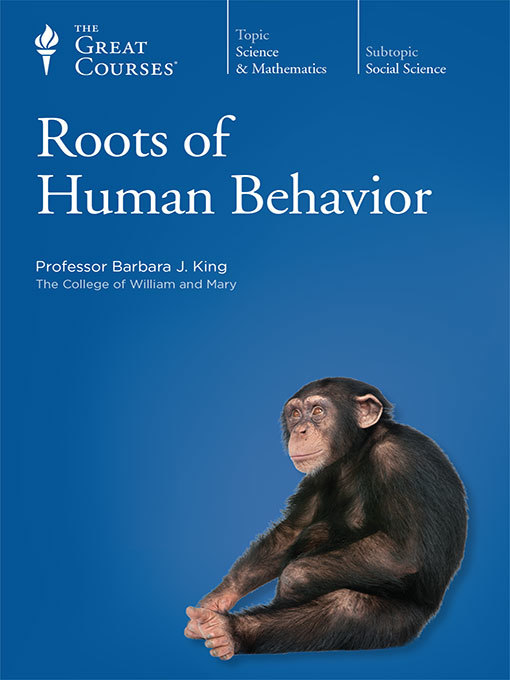Roots of Human Behavior

- BOOK NAME: Roots of Human Behavior
- AUTHOR: Professor Barbara J. King
- CATEGORY: Pure Science - 500
- LANGUAGE: ENGLISH
- YEAR: 2001
- PAGES: 60
star RATING
/5
- EXCERPT:
Note: Scientific names are italicized. The first term in a scientific name
refers to the genus grouping and the second, to the species grouping. When
no species term is given, that is because we want to speak broadly about the
genus rather than about one particular species.
Australopithecus afarensis. Gracile early hominids of Africa. The most
famous example is Lucy, discovered in Ethiopia in 1974. Lucy and others
of her type were bipedal hominids with small brains.
baboons (Papio). Many people mistakenly think of baboons as apes, but
they are large monkeys found in Africa. We concentrate in this course on
the savanna baboon, which lives in large multi-female, multi-male groups.
Males transfer at puberty; females tend to be related and closely bonded.
bonobos (Pan paniscus). Great apes found only in the Democratic Republic
of the Congo (the former Zaire) in Africa. Bonobos live in multi-female,
multi-male communities. Females transfer at puberty; males are related.
Social bonds between females and relatively equal status between males
and females set this species apart from its close relative the chimpanzee.
Bonobos are famous for their frequent and varied sexual behavior.
capuchins (Cebus). Small tree-dwelling monkeys of the New World
(Central and South America). Sometimes nicknamed “the ape of the New
World,” capuchins are well known for their ability, unusual in monkeys, to
make and use tools in the wild.
chimpanzees (Pan troglodytes). Great apes of Africa. Chimpanzees live in
multi-male, multi-female communities. Females transfer at puberty, and
males are related. Almost no social bonds exist between females, but
pronounced bonds among males are found. Males dominate females.
Chimpanzees are amazingly flexible tool users and tool makers.
gibbons and siamangs. Small-bodied lesser ape of Asia. Lesser apes are not
as closely related to humans as are the great apes. Gibbons and siamangs
spend their time entirely in the trees and tend to live in mated pairs.
gorillas (Gorilla gorilla). Great apes of Africa. Gorillas live in small groups
headed by one or two silverback males (large dominant males). Once
thought to be ferocious and terrifying, gorillas are, in fact, rather calm and
placid creatures except in certain rare circumstances.
48 ©2001 The Teaching Company
Homo erectus. The first hominid to migrate out of Africa and to populate
other areas of the world. First appearing nearly two million years ago,
Homo erectus is thought by many scientists to represent a shift point in
human evolution. This fossil form is associated with relatively advanced
stone tools, control of fire, and possibly, big game hunting.
Homo sapiens. Modern humans; we are Homo sapiens. The first indication
of modern anatomy appeared about 125,000 years ago in Africa. By 30,000
years ago, all other hominids were extinct except for Homo sapiens.
Japanese macaques (Macaca fuscata). Monkeys found in Japan. Like
savanna baboons, they live in multi-female, multi-male groups with female
dispersal and related males. One group of Japanese macaques is famous,
because one of its members invented new feeding methods that were then
passed along to others, perhaps by social learning.
Neandertals. Hominids that coexisted for long periods of time with Homo
sapiens, Neandertals bear little resemblance to the stereotypical “cave men”
of popular culture. These hominids, probably not modern humans’ direct
ancestors, were likely accomplished tool users and hunters.
orangutans (Pongo pygmaeus). The large red great ape of Asia. Entirely
tree dwelling, the orangutan lives only on the islands of Sumatra and
Borneo. Originally thought to be solitary by nature, orangutans are now
known to have important social bonds; one population is becoming famous
for its use and manufacture of tools.
vervet monkeys (Cercopithecus aethiops). Small monkeys of Africa.
Vervets, like savanna baboons and Japanese macaques, live in multi-male,
multi-female groups with female dispersal and related males. Using both
the ground and the trees, vervets are quite vulnerable to predators. In
biological anthropology, they are famous for having alarm calls that denote
specific predator types.




